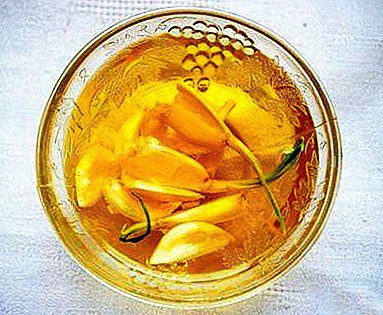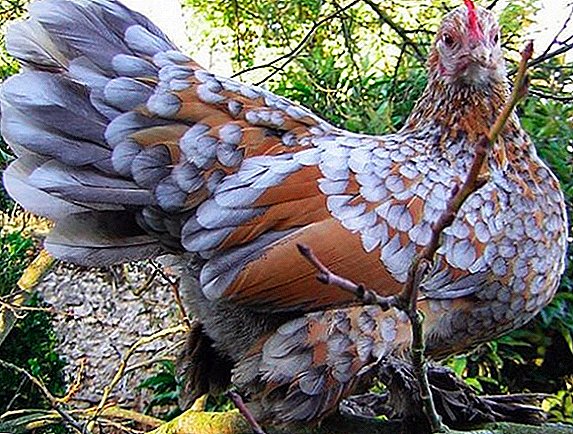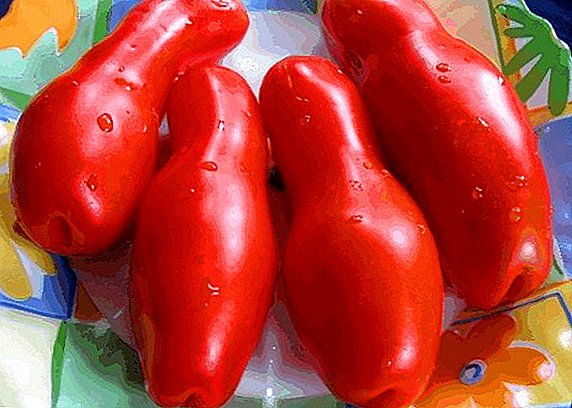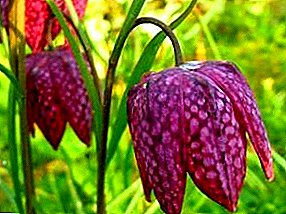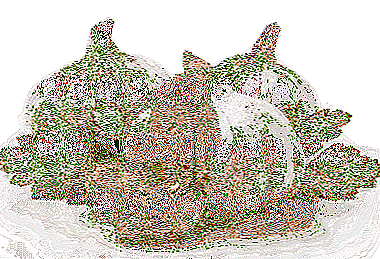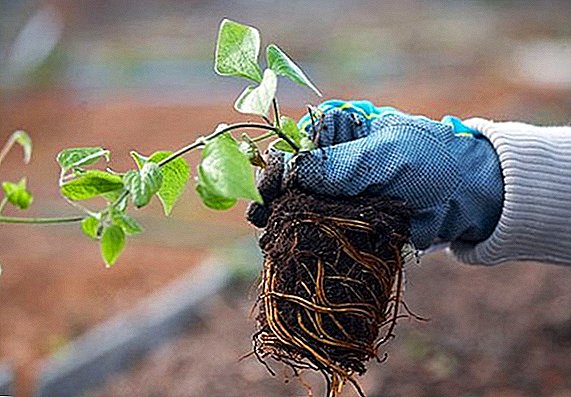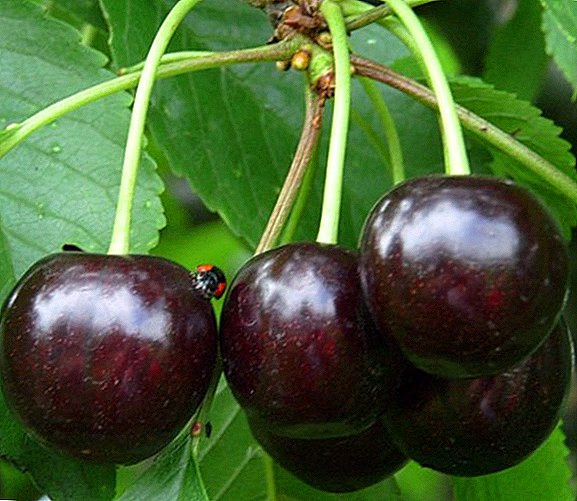 When choosing plants or trees for their plot, each summer resident focuses on the fecundity of a particular variety, although the requirements for planting and growing play a significant role in the choice situation. In this article we will talk about the characteristics and features of the care for the toilet "Night", which has a number of undoubted advantages in comparison with the usual varieties of cherries.
When choosing plants or trees for their plot, each summer resident focuses on the fecundity of a particular variety, although the requirements for planting and growing play a significant role in the choice situation. In this article we will talk about the characteristics and features of the care for the toilet "Night", which has a number of undoubted advantages in comparison with the usual varieties of cherries.
Description and characteristics
“Nochka” is an unusual cherry, since one of its “parents” is a sweet cherry. As a result of crossing the species, a tree appeared with the type of branching of one and the shape of the crown of the other.
Wood
This medium-thick tree grows up to three meters in height and is distinguished by a broad-pyramidal crown of medium thickening. Dark green, glossy leafy plates are somewhat larger than those of standard varieties, and the fruits are collected in brushes of 6-8 pieces each. The first flowers appear on the tree already in May, of course, if the weather is clear and warm outside.
Did you know? The variety "Nochka" was obtained by crossing the varieties of "Nord Star" and sweet cherry "Valery Chkalov". Authorship belongs to the Ukrainian breeder L. I. Taranenko.Cherry shoots are erect and smooth, completely covered with dark brown bark, and the buds located on them are very similar to cherry. In a word, even “Nochka” is considered to be cherry, in many respects it is rather a sweet cherry.

Check out the nuances of growing such varieties of cherries as "Meeting", "Putinka", "Shpanka", "Precious Carmine", "Winter Pomegranate", "Ashinskaya", "Turgenevka", "Vladimirskaya", "Shchedraya", "Zhukovsky" , "Izobilnaya", "Morozovka", "Ural Ruby", "Mayak", "Kharitonovskaya", "Molodezhnaya", "Black Large".
Fruits
The average fruits of the described cherry are much larger than the usual cherry, and their weight often reaches 7 g. Inside they have a wide heart drupe, surrounded by dense and juicy pulp, from which, if desired, you can get dark juice.
From the outside, cherries are covered with dark red glossy skins. Ripe fruits have a pleasant, but slightly sour taste (reminiscent of cherry), but their smell is rather cherry.  The stone is relatively freely separated from the pulp, so that the fruit can be easily prepared for consumption or processing. The tasting score of this grade is 4.6 points.
The stone is relatively freely separated from the pulp, so that the fruit can be easily prepared for consumption or processing. The tasting score of this grade is 4.6 points.
Some features of the variety
Each cultivated plant variety has its own characteristics that affect the possibility of their cultivation in a particular region and the requirements for this process. Consider the main nuances that are worth considering when cultivating the cherry "Night".
Winter hardiness and disease resistance
In addition to excellent taste, the described cherry has a number of other advantages, among which not in the last place are high frost resistance and good resistance to various ailments.
It will be useful for you to read about methods of dealing with major diseases and pests of cherries.
Due to its cold resistance, “Nochka” normally grows and develops even in regions with severe winters (up to -30 degrees), without requiring frequent preventive treatments from insects or diseases. 
Pollinators
One of the few shortcomings of the “Night” is its self-infertility, which is why other cherries will have to be planted nearby: “Youth”, “Nord Star”, “Lubskaya”, “Meteor”. It will also be nice to get a sweet cherry "Tenderness", which is no worse than coping with the role of pollinator.
Important! The distance between these trees should not exceed forty meters, and it is advisable not to plant other fruit trees between them (there will be no sense of pollen transferred to an apple tree or pear).
Ripening period and yield
The described variety can be called medium early, since cherries ripen closer to the middle or end of July. The tree reaches its peak of yield only at 12 years old, although active fruiting is observed already in the third year after planting.  Unfortunately, it will not be possible to collect more than 10 kg of a crop from a single cherry, but this is fully compensated by the taste characteristics of each fruit.
Unfortunately, it will not be possible to collect more than 10 kg of a crop from a single cherry, but this is fully compensated by the taste characteristics of each fruit.
Transportability
With proper collection, the collection capacity of the “Nochka” variety will be at its best. With or without a leg, you will be able to transport fruits over fairly long distances, which is especially important when growing cherries for commercial purposes.
Direction
Ripe drupes are excellent for both fresh consumption and for processing into compotes, jams, jams, marshmallow and other types of preparations. In addition, they can be dried and frozen, and with preservation of all useful properties. This is a universal solution for any hostess. 
Growing conditions
Before planting a variety on its territory, it is necessary to determine in advance the most suitable area for it. This version of cherry trees will grow well only on slightly acidic and fertile soils, well lit by the sun and closed from sudden gusts of winds.
It is also important to take into account the depth of groundwater, because the tree will not be able to develop normally in the places of their accumulation.
Landing rules
The best time for planting cherries on the site is considered to be early spring, since during the autumn carrying out the procedure, immature saplings may freeze in winter.
Important! The variety "Nochka" is represented by fairly large trees with a spreading crown, so when planting several seedlings between them, it is advisable to leave at least five meters of free space.

For this reason, even purchased copies in the autumn it is desirable to keep until spring, placing them temporarily in a cool cellar or dug in the soil. When the time comes, the young plant is taken out of storage and after a thorough examination (you need to make sure of the viability of the seedling) are transferred to planting.
We advise you to read about how to plant a cherry in the fall.
This process involves performing several sequential actions:
- 14 days prior to transplantation, the soil in the selected area should be dug up and fertilized with organic compounds, and at high acidity one will have to add dolomite flour or powder lime to the substrate.
- A week before planting, you can dig a planting pit, the size of which in this case should be at least 60x60 cm.
- It is useful to mix the top layer of the removed soil with humus and sand, taken in equal proportions, and only after that fill the bottom of the pit. The next will be a layer of ordinary land (without fertilizers).
- A few hours before the alleged planting of cherries, the soil in the planting pit should be moistened, so that by the time the seedling is placed the moisture is already absorbed.
- At the time of planting, the young plant must be kept vertically, well straightening all its roots.
- From above, the sapling root system is filled with the remaining soil, but only so that the root collar remains above the soil level. All voids formed between the roots must be filled by simply tamping down the substrate.
- At the end of planting around the cherry do a shallow hole and pour about 10 liters of water into it (if you wish, you can mulch the tree trunk with sawdust or humus).
How to care
For rapid growth and development, all trees need regular maintenance, and cherries are no exception. Representatives of the described varieties require compliance with the rules of irrigation, fertilizer, mulching and loosening, but it is especially worth considering the issue of pruning trees.
Hybrid cherries and cherries pruned as cherries, shortening the one-year gain by 1/3 of its length, which is useful for the correct formation of the crown. Let's take a closer look at all the features of the care of "Nochka".
Watering
After planting a seedling at the site, he begins a rapid growth of the root system, because of which the plant needs regular and abundant watering. In dry time, you will have to water the tree at least three times per season, pouring at least 15 liters of water under each seedling.  Adult hybrids tolerate drought well, so additional watering is not necessary. Over-flooding trees is not worth it, because stagnant moisture will cause the root system to rot. Waterlogging leads to cracks on the bark of the trunk and branches, as a result of which a gum appears.
Adult hybrids tolerate drought well, so additional watering is not necessary. Over-flooding trees is not worth it, because stagnant moisture will cause the root system to rot. Waterlogging leads to cracks on the bark of the trunk and branches, as a result of which a gum appears.
Basic irrigation should be carried out only during the flowering of trees and fruit ripening, and 2-3 weeks before the harvest begins, it is desirable to completely stop the application of liquid to the soil.
Top dressing
The grade "Nochka" does not need frequent fertilizers, and if a sufficient amount of nutrients were added to the pit when planting, the next feeding will be possible only after five years. For the preparation of the nutrient mixture, it is enough to mix 0.5 buckets of mullein with two of the same buckets of clean water and 0.5 kg of ash.  After a week of infusion and careful straining, this nutrient mass is simply poured under the tree, at the rate of 0.5 buckets per plant. To increase the yield, only two such supplements are enough, made in early spring and during flowering, and with the arrival of autumn, you can additionally sprinkle a mixture of phosphoric (200 g) and potash (80 g) fertilizers around the crown perimeter.
After a week of infusion and careful straining, this nutrient mass is simply poured under the tree, at the rate of 0.5 buckets per plant. To increase the yield, only two such supplements are enough, made in early spring and during flowering, and with the arrival of autumn, you can additionally sprinkle a mixture of phosphoric (200 g) and potash (80 g) fertilizers around the crown perimeter.
Important! Nitrogen-containing compounds should be treated with special attention, since an excessive amount of this component will lead to a rapid growth of the crown.
Soil care
Adult cherries are fairly resistant to external adverse factors, however, they also need periodic tillage in the tree trunks. Therefore, every time after watering the soil, it is desirable to loosen and remove weed plants from it, and at the end of the procedure, this area can be mulched with peat, straw, or slightly dried grass.  Mulching helps to retain moisture and inhibits the re-development of weeds, but in rainy periods it is better to remove the layer in order to prevent sediment stagnation in the root system of “Nochki”.
Mulching helps to retain moisture and inhibits the re-development of weeds, but in rainy periods it is better to remove the layer in order to prevent sediment stagnation in the root system of “Nochki”.
Pruning
The hybrid forms of cherry before the onset of the fruiting period are characterized by very rapid growth, therefore sanitary pruning is one of the obligatory and regular measures in the care of the described variety.
Learn more about the rules of spring and autumn pruning cherry.
Usually, the procedure is performed in spring and before hibernation, removing all broken, dry and frozen shoots, and annual branches are cut only by 1/3 of their length. All work can be done with sharp garden shears, and it is advisable to immediately treat the cut points with a garden bar.
Video: cherry pruning
Preparing for the winter
As we noted earlier, the cherry “Nochka” is distinguished by a rather high resistance to cold, however, in case of strong frosts, it is advisable to organize a shelter (especially for young plants).
The snow mixed with sawdust will help protect the tree from the cold. It is desirable to protect young saplings with metal cylinders, which today are easy to find in gardening stores.
Did you know? The historical homeland of cherry is considered to be the territory of modern Iran, but on Russian soil it appeared only in the XIY century and at first was not particularly popular.

Advantages and disadvantages
Many gardeners already know and love the sort of “Nochka” very much, often giving preference to him. This is not surprising, because the benefits of growing such a lot of such a lot:
- It is excellent against frosts, so that cultivation is possible in the most northern regions of the country with an unfavorable climate.
- It has excellent immunity to various diseases and pests (this greatly simplifies care, because for prevention only a few treatments are required per year).
- Brings a good harvest of tasty and large berries of universal appointment which besides have simply excellent trade dress.
- Relatively unpretentious care and does not require frequent watering or fertilizing.
We recommend to get acquainted with the description of large-fruited, medium and early varieties of cherries.

As for the weak points of the “Night”, they include relatively low yields (only 10 kg of fruit from one tree) and large sizes of the tree itself (to plant a garden, you need to have a large area).
Simply put, if you grow cherries for yourself, and not for sale, then “Nochka” certainly deserves your attention and will surely please all households.


